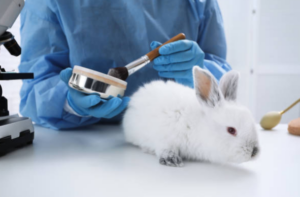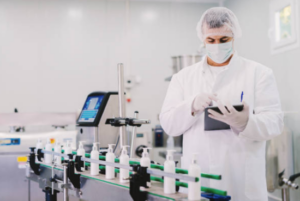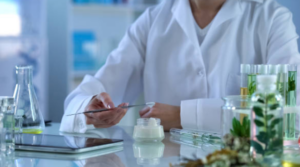Behind the Mascara Wand

In the world of beauty, our makeup bags are filled with an array of products that help us feel confident and glamorous. From lipsticks to eyeshadows, our favorite cosmetics have the power to transform us. However, there’s a side of the beauty industry that remains hidden behind the allure of glamorous packaging and promises of radiant skin. This is the world of cosmetic testing on animals, particularly bunnies.
In recent years, there has been growing awareness and concern regarding the ethical implications of animal testing in the cosmetics industry. This blog aims to shed light on the truth about cosmetic testing on bunnies, why it continues to be a pressing issue, and the steps being taken to put an end to this practice.
The Unseen Reality: Cosmetic Testing on Animals
For many years, animals, including rabbits, have been subjected to a wide range of tests to determine the safety and efficacy of cosmetic products. These tests often include procedures such as skin and eye irritation tests, force-feeding, and even lethal dose toxicity tests. The purpose is to assess potential adverse reactions that cosmetic products might have on humans.
Rabbits, in particular, are used in eye irritation tests, where substances are applied directly to their eyes to observe the effects. These tests can cause extreme discomfort, pain, and even permanent damage to the rabbits’ eyes. Furthermore, the rabbits are often confined to small cages, leading to a life of suffering and stress.
Why Bunnies? The Perceived Innocence
Rabbits are often the animals of choice for cosmetic testing due to their perceived innocence and docile nature, but delving deeper into this aspect reveals the unsettling truth about their exploitation in the cosmetics industry.
Rabbits are gentle, non-aggressive animals by nature. This makes them more manageable during testing procedures, as they tend not to exhibit aggressive behavior when subjected to experiments. Their passive behavior makes them a convenient choice for researchers, but it also underscores the moral dilemma of exploiting these innocent creatures.
The vulnerability of rabbits further contributes to their selection for cosmetic testing. These animals, with their soft fur and large, expressive eyes, elicit empathy and compassion from those who come into contact with them. The cosmetics industry, in many ways, capitalizes on the very empathy these animals invoke, as the images of rabbits are used in campaigns for cruelty-free cosmetics and animal rights initiatives.
While there are legal frameworks in place in various regions to protect animals from harm and cruelty, there are often exceptions and loopholes that allow for animal testing. As a result, rabbits and other animals often lack the legal protections necessary to shield them from suffering in the name of cosmetics.

The Global Movement Against Animal Testing
The movement against animal testing in the cosmetics industry has gained significant momentum in recent years, reflecting a growing global awareness of the ethical and moral implications of these practices. Governments, organizations, and consumers are actively working to end the suffering of animals used in cosmetic testing. Here, we explore the key developments in this global movement and the efforts made to create a more compassionate and cruelty-free beauty industry.
1. The European Union (EU) Ban:
In 2009, the European Union took a groundbreaking step by implementing a comprehensive ban on the sale of cosmetics tested on animals. This ban marked a significant turning point and set a powerful precedent for the rest of the world. It sent a clear message that cosmetics companies needed to find alternative testing methods to continue selling their products in the EU. The EU’s move showcased that cruelty-free beauty was not only achievable but also a necessary ethical step.
2. Cruelty-Free Certifications:
Several organizations and certifications have emerged as driving forces behind the global movement against animal testing. Notably, Leaping Bunny, PETA’s Beauty Without Bunnies, and other organizations have worked tirelessly to establish criteria for cruelty-free cosmetics. Brands that meet these criteria receive certification, allowing consumers to make informed choices and support cruelty-free companies.
3. Legislative Progress:
Many countries and regions around the world are implementing or considering bans on cosmetic testing on animals. For instance, Australia, Canada, New Zealand, and India have imposed partial or full bans, while other countries are actively exploring similar legislation. In the United States, individual states have taken action, with California, Nevada, and Illinois implementing bans on the sale of newly animal-tested cosmetics. These legislative changes reflect growing concern and commitment to ending animal suffering in the cosmetics industry.
4. Global Market Shift:
Consumer demand for cruelty-free products is reshaping the beauty industry. Major cosmetic brands have responded to this demand by making public commitments to go cruelty-free. Many of these brands have begun to phase out animal testing and offer cruelty-free products, often marking them with labels that signify their commitment to ethical practices. This shift not only aligns with consumer values but also encourages other companies to follow suit to remain competitive.
5. Awareness and Education:
Education and awareness campaigns have played a vital role in the fight against animal testing. Organizations and individuals dedicated to animal rights have used social media, documentaries, and educational materials to expose the harsh realities of cosmetic testing on animals. By raising awareness and providing information, they have empowered consumers to make informed choices and become advocates for change.
6. Scientific Advancements:
Scientific research has paved the way for alternative testing methods that are both more humane and scientifically reliable. These methods, such as in vitro testing using human cell cultures and tissues, computer modeling, and artificial skin models, provide accurate data without causing harm to animals. They are not only more ethical but also cost-effective, demonstrating that cruelty-free testing is not only a moral imperative but also a practical one.
7. International Collaboration:
Global organizations like the World Health Organization (WHO) are working to promote the development and acceptance of alternative testing methods. Collaboration on a global scale is essential to ensure that cruelty-free testing becomes the industry standard worldwide.

The Alternatives to Animal Testing
While the movement to end animal testing is gaining momentum, there’s still work to be done. The challenge lies in finding alternative methods to assess the safety of cosmetics. Fortunately, scientific advances have led to the development of non-animal testing methods, which are not only more humane but also often more accurate and cost-effective.
Here are some of the alternative testing methods currently being used:
1. In Vitro Testing:
In vitro testing involves using human cell cultures and tissues to evaluate the safety of cosmetic ingredients. This method can provide more accurate results, as it uses human cells, which are directly relevant to human reactions.
2. Computer Modeling:
Sophisticated computer models simulate the effects of cosmetic ingredients on human tissues. This method is not only cruelty-free but also cost-efficient.
3. Artificial Skin:
Advanced technologies have led to the creation of artificial skin models that closely mimic human skin, making them a valuable tool in assessing skin irritations without the need for animal testing.
4. Human Volunteers:
Human volunteers who are willing to participate in clinical trials can provide essential data on the safety and efficacy of cosmetic products. Ethical guidelines and informed consent ensure their safety.
If you’re passionate about putting an end to cosmetic testing on animals, there are several steps you can take to make a difference:
1. Choose Cruelty-Free Products:
One of the most effective ways to support the movement is by purchasing products from brands that are certified as cruelty-free. Look for labels or certifications from reputable organizations.
2. Educate Yourself and Others:
Spread awareness about the issue by sharing information with your friends and family. The more people understand the problem, the more likely they are to support cruelty-free products.
3. Contact Your Legislators:
Advocate for stricter regulations and laws that ban animal testing for cosmetics in your region or country. Writing to your legislators or signing petitions can help bring about change.
4. Support Cruelty-Free Brands:
Support brands that have made the commitment to go cruelty-free. By choosing their products, you encourage more companies to follow suit.
5. Use Your Voice on Social Media:
Social media can be a powerful platform for raising awareness. Share posts, articles, and images that highlight the issue of animal testing in the cosmetics industry.
6. Support Animal Rights Organizations:
Consider donating to or volunteering with organizations that are actively working to end animal testing in the beauty industry.

As we continue to evolve as a society, our compassion for all living creatures should evolve as well. The cosmetic industry’s movement away from animal testing is a step in the right direction, and it’s heartening to see the positive changes that have occurred in recent years.
By choosing cruelty-free products and advocating for change, you can contribute to a world where bunnies and other animals no longer have to endure pain and suffering in the name of beauty. Together, we can work towards a future where all products are created with ethics and compassion in mind, ensuring that no bunny ever has to pay the price for our cosmetics.

